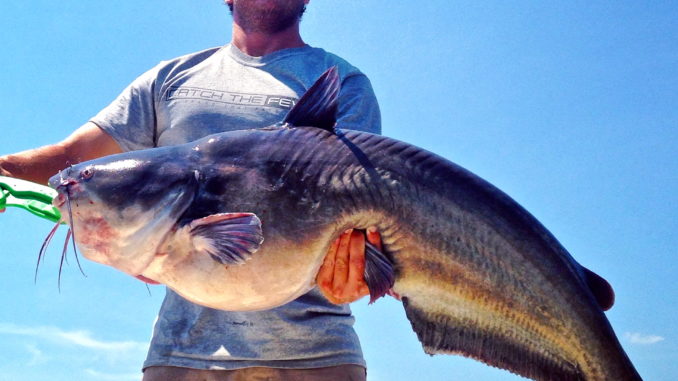
When targeting late-summer blue cats, know where the thermocline is and fish there
Contrary to popular belief, blue catfish are not just bottom-feeders. Once the lowest layer of water is depleted of oxygen in late summer, big blues have to change their game plan. Guide Zakk Royce of Murfreesboro consistently puts them in the boat by suspending cut bait with slip bobbers. Follow his tips to dial in on the thermocline bite.
Find the thermocline. “Simply put, the thermocline is the layer of water that has the most oxygen and coolest water,” said Royce (252-398-7192), who runs Zakk’s Guide Service on Lake Gaston. “The fish can be so concentrated to that layer that you can’t even get a bite on the bottom.”
According to Royce, this stratified is lies sandwiched between the cooler, low-oxygen bottom layer and the much warmer, oxygen-filled top layer. Finding the thermocline is a matter of increasing the sensitivity of your sonar until a fine line develops across the screen, indicating that the signal is bouncing off the cooler, denser water. Also, simply noticing the depth at which baitfish and smaller fish are holding, will give away the comfort zone.
Understand slip bobber basics. “Let’s say the fish are 10 feet down, in 20 feet of water,” said Royce. “Imagine using a regular clip-on bobber; you would have to slide it up 10 feet from your hook. Obviously, that is nearly impossible to cast. Here’s the beauty of the slip bobber rig, you attach a bobber stop and when you cast it, the bobber stop will hit the top of your slip bobber, and your bait will be however deep you set it to be.”
Royce sets up by threading the main line through the top of a relatively large slip bobber and out of the other side. That line goes through a 2- to 3-ounce egg weight and ties to a sturdy swivel. Then, a 50- to 60-pound leader runs from the swivel to an 8/0 to 10/0 circle hook. The bobber slides freely between where the stop is set and the swivel. Royce baits up with either cut gizzard shad or white perch.
Drift using windsocks. “For drifting, you really need a trolling motor, some wind, or good current,” said Royce. “A drift sock is a very good investment to make; it will help you control the boat speed and keep the drift straight.”
When applicable, Royce will throw one sock off the stern and one off the bow, allowing him to drift sideways and use up to six rods at a time.
Look for structure that rises near the thermocline. Once the thermocline has been established, any abnormalities such as a hump, point, ridge or submerged timber that elevates from the bottom near this comfort zone is a likely ambush spot for blues. For example, Royce’s most recent trophy was an 81-pounder caught suspended over submerged timber in 35 feet of water on a bait drifting 15 feet deep.




Be the first to comment